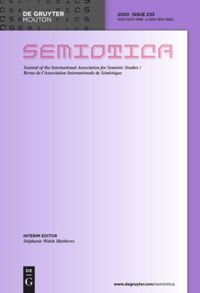Fionn Bennett – « Saussure’s “anagrams”: A case of acousmatic mistaken identity? », in Semiotica 2021/238, pp. 181-198 (November 2020).
DOI: https://doi.org/10.1515/sem-2019-0009
Published Online: 2020-11-18.
Published in Print: 2021-01-27.
https://www.degruyter.com/document/doi/10.1515/sem-2019-0009/html

Abstract
In the course of his painstaking study of ancient verse, Ferdinand de Saussure came up with an intriguing theory about the phonetics of the poetry he scrutinised. He postulated that the “jeux phoniques” he detected in the texts he analysed was proof that their authors were attempting to “parasite” the surface level meaning of their verse with a “hypotexte.” This hypotexte consisted of “anagrams” of “mots thèmes” whose phonetic properties were “isosyllabically diffracted” throughout the rest of the host text. Today it is generally accepted that Saussure was wrong about this. Few however maintain that what he discerned in the phonetic depths of the verse he auscultated was no more than the figment of a fertile imagination. But if this be so, what exactly had he detected? This paper maintains that what Saussure stumbled upon was the trace of a contribution made to ancient verse by melodically and metrically organised sounds. This was inevitable. Virtually all the texts he probed were “carmina sacra” that were composed to be sung and accompanied by music. This musical accompaniment had a decisive impact on the phonetics of the “lexemic” words in the Poetry that has survived. This is so because sung verse cannot “euphoniously” accommodate a musical accompaniment unless its phonetics constituents are selected, concatenated and intoned in such a way as to follow the melodic contours and rhythm patterns that modulate their articulation. In addition, the point of making verse consist both of melodically organised arrangements of sound and of organisations of sound in which one can recognise ordinary words was not simply ornamental. The real point was to bi-nature what one was hearing. In other words, the goal was to “over-signify” the usual meanings of the “logocentric” words in the verse with a separate but complementary meaning and narrative encoded in melodised tones and metered rhythms. Why qualify the accompanying music as “acousmatic voices”? Because the music in question was added to song to give a voice to whichever tutelary divinity the song was performed to honour. That’s what makes “acousmatic voices” an especially apt epithet for characterising the melodically and rhythmically structured bodies of sound Saussure so presciently discerned in the phonetic depths of the poésie phonisante he probed. The point of their being in poetry was to give a voice to the agencies to whom the object or occasion of verse is beholden for its Being-in-the-world.
Keywords: Ferdinand de Sausssure; anagrams; musical meaning; acousmatic voices; comparative poetics; hieroglossia

